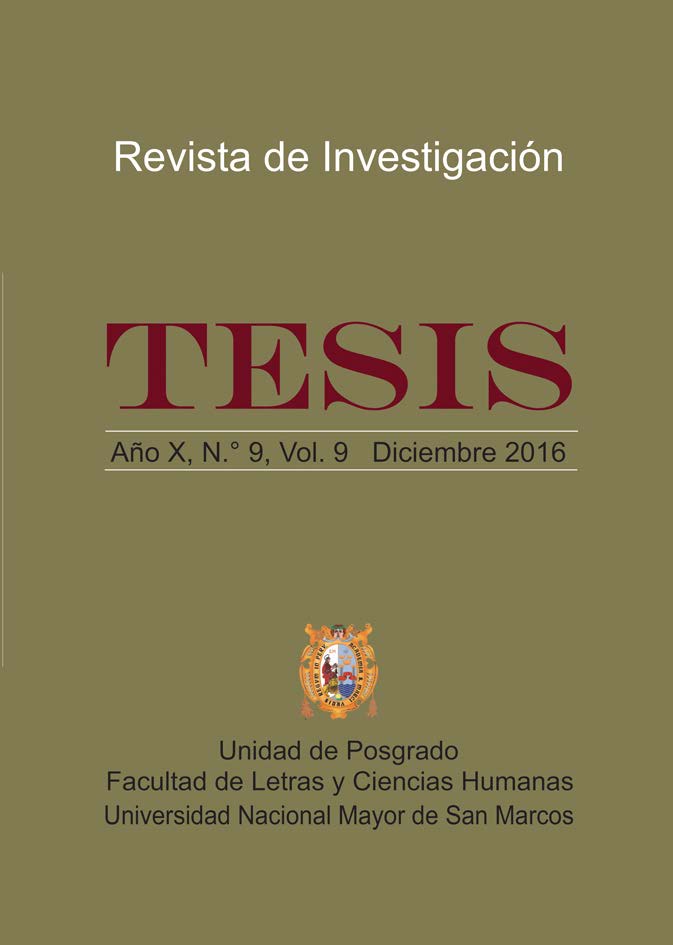The historical account and the myth in Rosa Cuchillo
DOI:
https://doi.org/10.15381/tesis.v9i9.23507Keywords:
historic story, myth, dialogue, terrorism, Andean worldAbstract
Rosa Cuchillo, novel of the peruvian writer Oscar Colchado Lucio, treats about the terrorism in the eighties decade. The important aspect about the text is the andean perspective about the violence against the runa. Colchado proposes an opened andean point of view, capable to talk and find things in common with the Other. In Rosa Cuchillo, the quechua culture is part of the solution, not the problem. In order to do that, the author constructs two antagonic characters: Inkarri and the pishtaco or nakaq. The first one is represented by Liborio, the second, by Sendero Luminoso and the peruvian government. The author creates tension among both characters, that produces crisis in the andean world. In order to solve the conflict, Liborio proposes an alternative way that involves Sendero. We want to focus on the construcción of both characters. We affirm that the author uses the historic story and the myth in order to create the cultural hero of the text. In the case of Liborio, we can identify elements of the Atahualpa, Tupac Amaru I and Tupac Amaru II stories. By the other hand, we can find the pishtaco or nakaq story in the prehispanic time. We will see how the nakaq concept gets new meanings in crisis times.
References
Ansión, Juan. (1987). Desde el rincón de los muertos. El pensamiento mítico en Ayacucho. Lima: Gredes.
Ansión, Juan. (1989). Pistachos de verdugos a sacaojos. Lima: Tarea.
Arguedas, José María. (1953). Cuentos mágico-realistas y canciones de fiestas tradicionales. Folklore Americano, XI, (1), pp.101-128.
Burga, Manuel. (1988). Nacimiento de una utopía: muerte y resurrección de los incas. Lima: Instituto de Apoyo Agrario.
Certeau, Michel de. (1993). La historia de la Historia. México: Departamento de Historia de la Universidad Iberoamericana.
Colchado Lucio, Oscar. (2005). Rosa Cuchillo. Lima: Editorial San Marcos.
Degregori, Carlos Iván. (1989). Entre los fuegos de Sendero y el Ejército: Regreso de los Pishtacos. En: Ansión, Juan. Pishtacos: de verdugos a sacaojos (pp.109-114). Lima: Tarea.
Flores Galindo, Alberto. (1988). Buscando un Inca. Identidad y utopía en los Andes. (3era ed.) Lima: Editorial Horizonte.
Gonzales, Odi. (2014). Elegía Apu Inka Atawallpaman. Primer documento de la resistencia Inka (Siglo XVI). Lima: Pakarina.
Hobsbawn, Eric. (2012). La invención de la tradición. Barcelona: Crítica.
Kapsoli, Wilfredo. (1984). Ayllus del sol. Anarquismo y utopía andina. Lima: Tarea.
Morote Best, Efraín. (1983). Aldeas Sumergidas. Cultura popular y sociedad en los Andes. Cusco: Centro de Estudios Rurales Andinos “Bartolomé de las Casas”.
Ossio, Juan. (1973). Ideología mesiánica del mundo andino. Lima: Edición de Ignacio Prado Pastor.
Pease, Franklin. (1973). El Dios creador andino. Lima: Mosca Azul Editores.
Romero, Raúl. (2004). Identidades múltiples: memoria, modernidad y cultura popular en el valle del Mantaro. Lima: Fondo Editorial del Congreso del Perú.
Vargas Llosa, Mario. (1999). Informe sobre Uchuraccay. Contra Viento y marea III. (79-114). Lima: Peisa.
Walker, Charles. (2015). La rebelión de Túpac Amaru. Lima: IEP.
Downloads
Published
Issue
Section
License
Copyright (c) 2016 Hardy Rojas Prudencio

This work is licensed under a Creative Commons Attribution 4.0 International License.
THE AUTHORS RETAIN THEIR RIGHTS:
(a) The authors retain their trademark and patent rights, and also on any process or procedure described in the article.
(b) The authors retain the right to share, copy, distribute, execute and publicly communicate the article published in Tesis (Lima) (in example, depositing the article in an institutional repository or publish it in a book), with recognition of its initial publication in the Tesis (Lima).
(c) The authors retain the right to make a later publication of their work, to use the article or any part of it (for example: a compilation of their works, notes for conferences, thesis, or for a book), provided that they indicate the source of publication (authors of the work, magazine, volume, number and date).






